Sigma 35mm F1.4 DG HSM Review

Introduction
The Sigma 35mm F1.4 DG HSM is a new prime lens for full-frame and APS-C DSLR cameras. It offers the equivalent angle of view as a 52.5mm lens on an APS-C system (depending on the crop factor). The Sigma 35mm F1.4 DG HSM features a rounded 9 blade diaphragm which creates an attractive blur to the out of focus areas of the image. It has a minimum focusing distance of 30cm /11.8in and a maximum reproduction ratio of 1:5.2. The Sigma 35mm F1.4 DG HSM is the first lens in the new Art line (the other ranges are Contemporary and Sports). The Sigma 35mm F1.4 DG HSM lens is currently available for £799.99 / $899.99 in the UK and the US, respectively.
Ease of Use
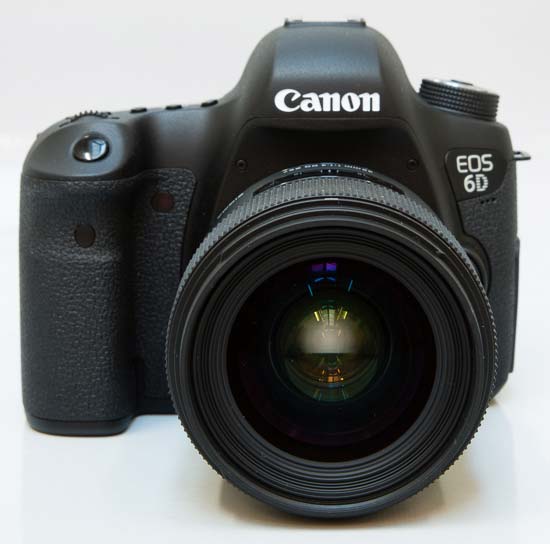 The Sigma 35mm F1.4 DG HSM lens mounted on a Canon EOS 6D
The Sigma 35mm F1.4 DG HSM lens mounted on a Canon EOS 6D
Weighing in at 665 grams and measuring 9.4cm in length, the Sigma 35mm F1.4 DG HSM is quite a big lens given its focal length, and signficantly larger and heavier than the new Canon EF 35mm F/2 lens that we tested at the same time. As seen in the photos below, it complements a full-frame camera like the Canon EOS 6D very well and also doesn't look out of place on a smaller APS-C camera like the Canon EOS 650D.
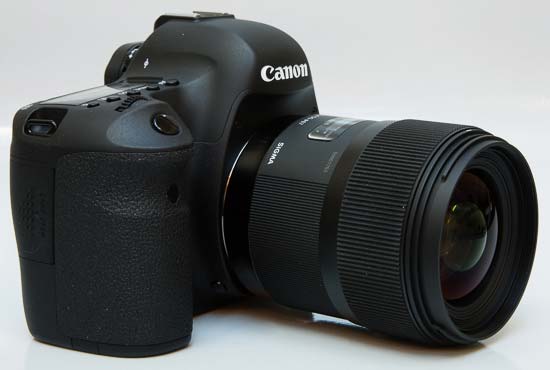 The Sigma 35mm F1.4 DG HSM lens mounted on a Canon EOS 6D
The Sigma 35mm F1.4 DG HSM lens mounted on a Canon EOS 6D
 The Sigma 35mm F1.4 DG HSM lens mounted on a Canon EOS 6D
The Sigma 35mm F1.4 DG HSM lens mounted on a Canon EOS 6D
 The Sigma 35mm F1.4 DG HSM lens alongside a Canon EOS 6D
The Sigma 35mm F1.4 DG HSM lens alongside a Canon EOS 6D
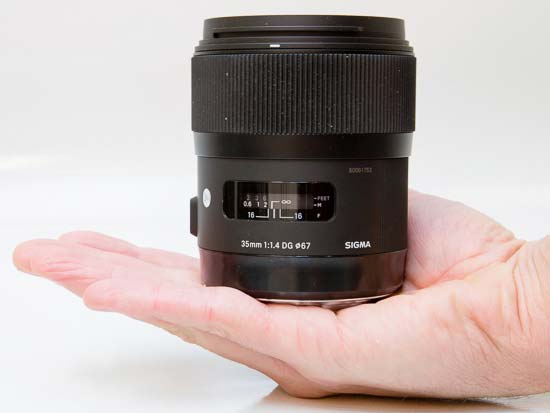 The Sigma 35mm F1.4 DG HSM lens in-hand
The Sigma 35mm F1.4 DG HSM lens in-hand
Build quality is excellent given the comparatively affordable price tag. The lens has a plastic shell with a mixture of metallic parts and a new compound material, TSC (Thermally Stable Composite), used inside. It also incorporates a brass bayonet mount that's supposed to be more durable. The optical elements are made of high-grade glass. The focus ring is pleasingly wide and ridged for easier grip.
 Front of the Sigma 35mm F1.4 DG HSM lens
Front of the Sigma 35mm F1.4 DG HSM lens
In terms of features, the Sigma 35mm F1.4 DG HSM offers all the basics that you need from a prime lens. The main exception is the lack of built-in Vibration Reduction, although the very fast maximum aperture of f/1.4 makes up for this.
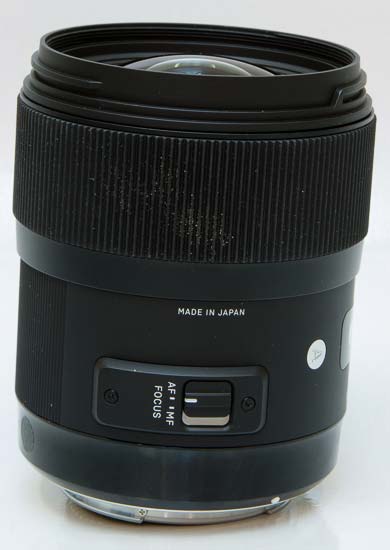 Front of the Sigma 35mm F1.4 DG HSM lens
Front of the Sigma 35mm F1.4 DG HSM lens
Focusing is usefully internal and manual focusing is possible when set via the Focus switch on the lens barrel. Full-time manual focus override is also available at any time simply by rotating the focus ring.
A clear distance scale in both feet and meters runs from the closest focusing distance of 0.3m / 0.99 ft to infinity.
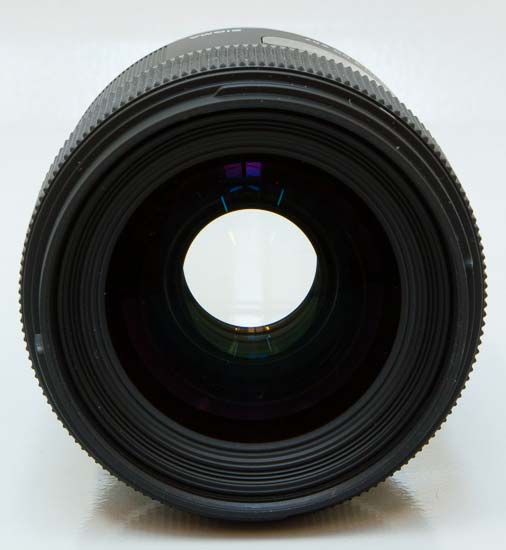 Front of the Sigma 35mm F1.4 DG HSM lens
Front of the Sigma 35mm F1.4 DG HSM lens
Surprisingly given its price, the Sigma 35mm F1.4 DG HSM ships with a good quality soft case and also a plastic petal-shaped lens hood. It accepts 67mm filters.
 Rear of the Sigma 35mm F1.4 DG HSM lens
Rear of the Sigma 35mm F1.4 DG HSM lens
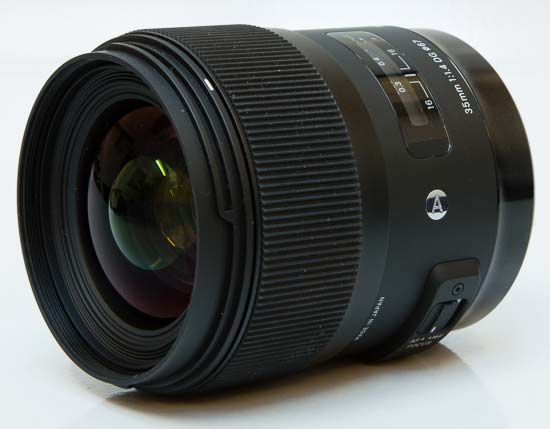 Front of the Sigma 35mm F1.4 DG HSM lens
Front of the Sigma 35mm F1.4 DG HSM lens
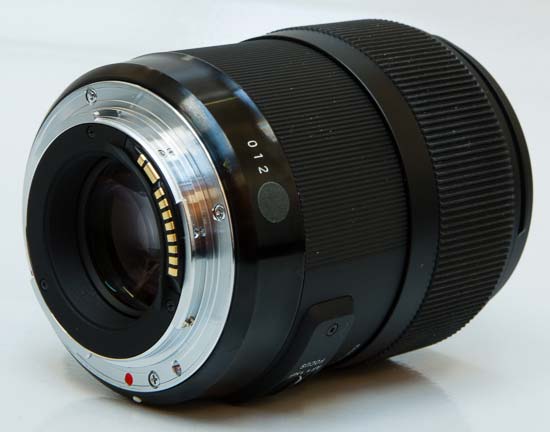 Rear of the Sigma 35mm F1.4 DG HSM lens
Rear of the Sigma 35mm F1.4 DG HSM lens
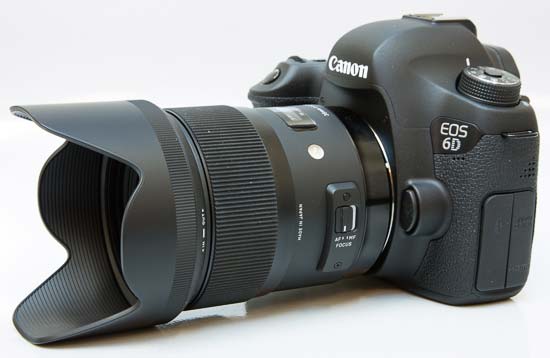 Front of the Sigma 35mm F1.4 DG HSM lens, with the supplied LH730-03 lens hood fitted
Front of the Sigma 35mm F1.4 DG HSM lens, with the supplied LH730-03 lens hood fitted
Focal Range
At the 35mm focal length the angle of view is 63.4 degrees.
 Field of view at 35mm
Field of view at 35mm
Focusing
The Sigma 35mm F1.4 DG HSM lens has a wide focus ring. There are no hard stops at both ends of the range, making it a little more difficult to set focus at infinity. Polariser users should be pleased that the 67mm filter thread doesn't rotate on focus.
When it comes to auto-focusing, the Sigma 35mm F1.4 DG HSM zoom is a quick performer, taking about 0.15 seconds to lock onto the subject when mounted on the Canon EOS 6D that we tested it with.
We didn't experience much "hunting", either in good or bad light, with the lens accurately focusing almost all of the time. It's also a very quiet performer, thanks to the built-in HSM (Hyper Sonic Motor), which makes this lens well-suited to video recording.
Chromatic Aberrations
Chromatic aberrations, typically seen as purple or blue fringes along contrasty edges, can be detected in some shots but they are not very prominent at all.
 |
 |
Light Fall-off
With the lens set to its maximum aperture of F1.4, there is significant light fall-off in the corners. Stopping-down to F/4 virtually eliminates this.
 Light fall-off
Light fall-off
Macro
The Sigma 35mm F1.4 DG HSM isn't claimed to be a macro lens, but it delivers quite good performance nonetheless. It has a minimum focusing distance of 30cm/11.8in and a maximum magnification ratio of 1:5.2. The following example demonstrates how close you can get to your subject, in this case a Compact Flash memory card.
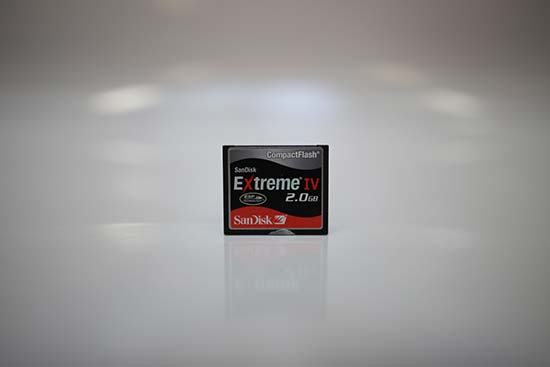 Close-up performance
Close-up performance
Bokeh
Bokeh is a word used for the out-of-focus areas of a photograph, and is usually described in qualitative terms, such as smooth / creamy / harsh etc. In the Sigma 35mm F1.4 DG HSM lens, Sigma employed an iris diaphragm with nine rounded blades, which has resulted in nice bokeh in our view. We do realise, however, that bokeh evaluation is subjective, so we've included several 100% crops for your perusal.
 |
 |
 |
 |
Sharpness
In order to show you how sharp this lens is, we are providing 100% crops on the following page.
